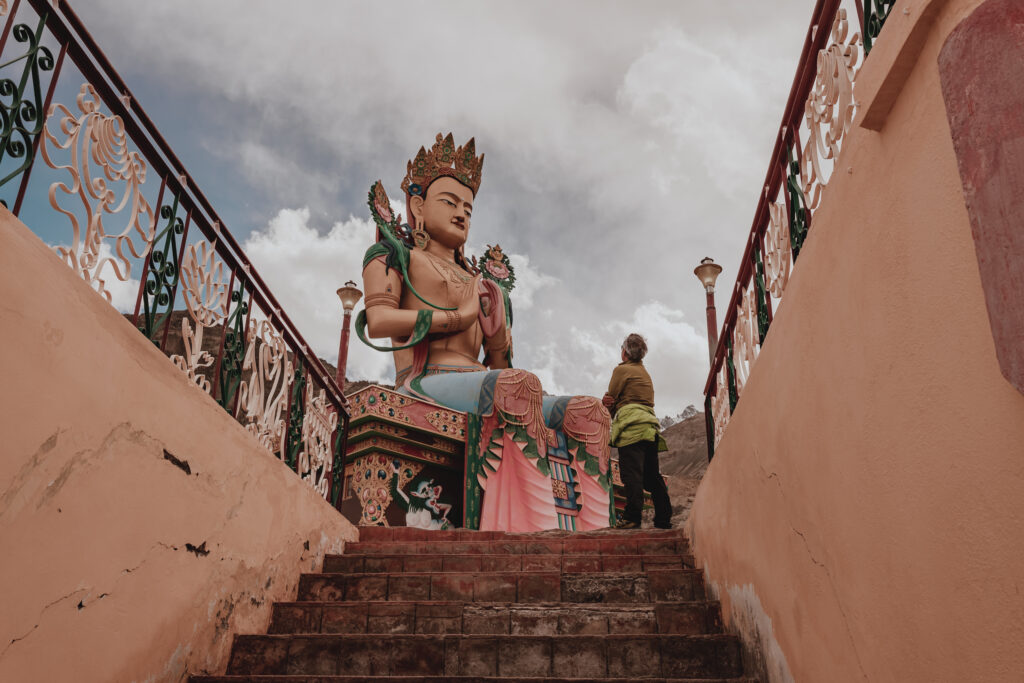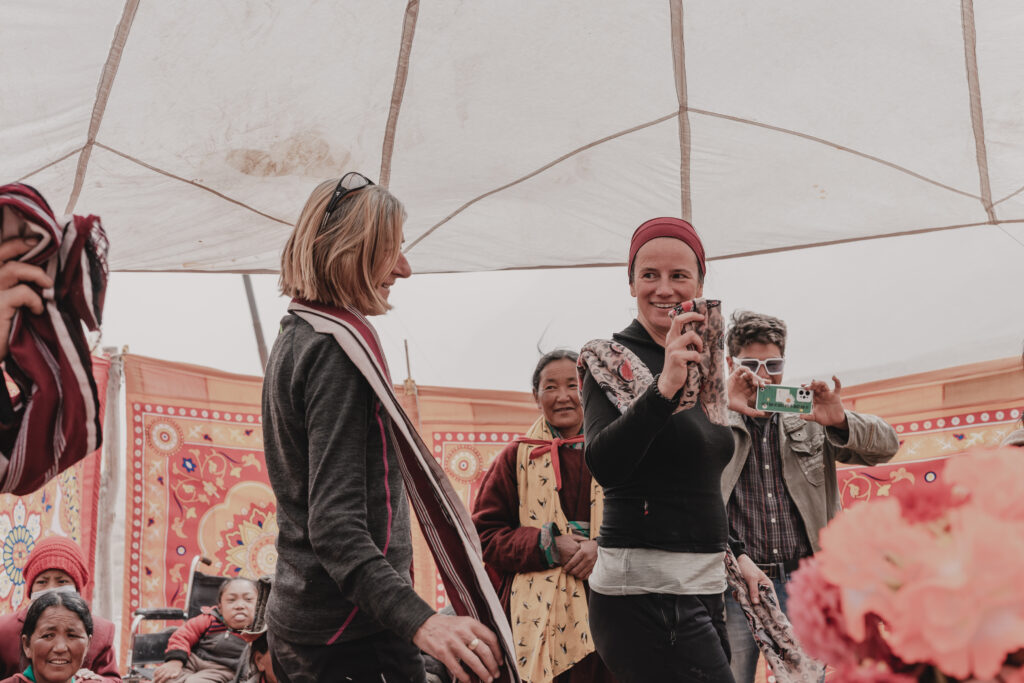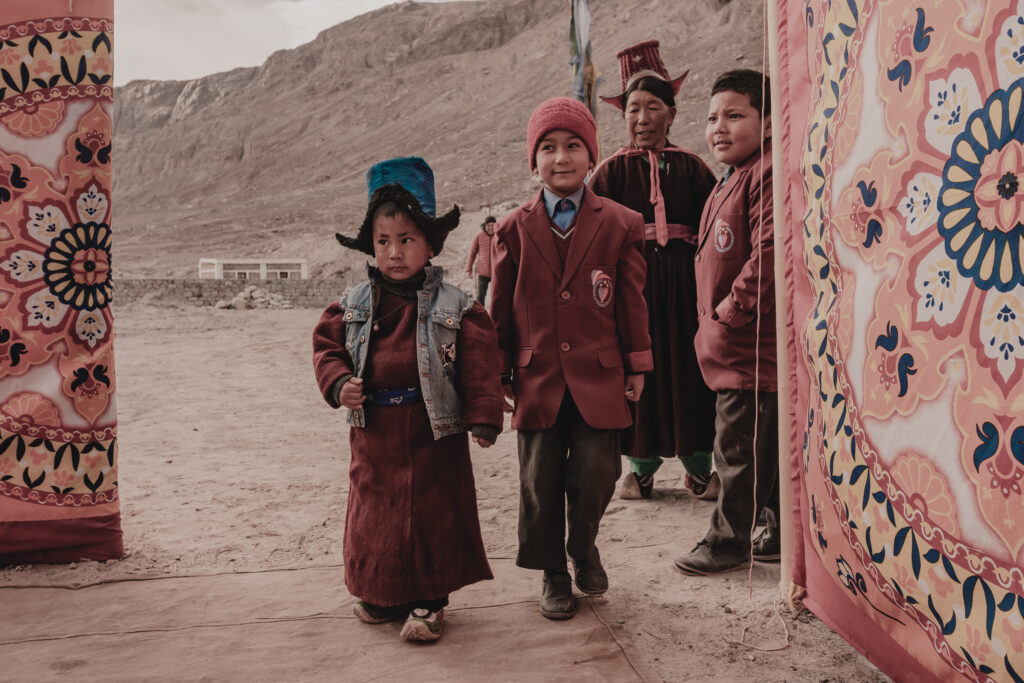I slid open the frosted window and stuck my head out into the cold, white void. With not much to see in this snowstorm at 5,000 metres, I looked down and saw Dorjay’s legs sticking out from under the van, his gray And 1 sweatpants were outlined against the snow as he struggled to re-affix our faulty snow chains so we could safely descend the mountain pass and conclude our expedition. Feeling calm in his capable hands, I began to welcome the prospect of the Kardung La throwing us back, granting us a few more wild days in this former silk road kingdom that felt like nowhere else in India.
We had arrived eleven days prior, our plane from Delhi touching down at the small, dusty airport in a militarised zone outside of Leh, Ladakh. The surrounding grey walls of the Indus valley were crowned with high, icy spires, but nearer to hand were grim, walled army compounds lining the motorways between the airport and our hotel. The geopolitical tensions of the contested India-China border were far from our minds, however, as we were in the warm company of Paras Loomba and his colleagues from Global Himalayan Expedition (GHE). An electrical engineer by trade, a transformative experience in Antarctica inspired Paras to found a company at the intersection of engineering and tourism, enlisting travellers to provide solutions to the climate crisis. Since 2013, GHE has electrified over 100 communities in India. One such project was Phyang monastery, where we soon found ourselves awash in guttural Buddhist chanting to the beat of a drum, the smoky whisps of incense drifting up to aged frescoes in the faint light as a monk prayed for a safe and fruitful expedition to come. We spent our first three days acclimatising to the dizzying elevation of Leh (3500m).

Those acclimatisation days exploring Leh and the surrounding valley drove home the point to us that GHE was not simply providing light, they were providing livelihood. On top of the challenges presented by the climate crisis, the migration of villagers to the cities in search of labour is an immediate threat to the longevity of many communities. GHE addresses this by developing otherwise isolated villages into destinations. Paras explained that the Coronavirus pandemic triggered a shift in trends away from congested hotels in big cities toward small homestays in more secluded areas. Once these villages become electrified, homeowners can partner with GHE to receive support in converting to homestays, allowing them to earn an income from travellers, thus delaying the migration to the cities. How do they find these partners? Paras explained that “expeditions are the inroads to new destinations.” Meaning that once an expedition completes a project for a certain village, the indirect effect is such that word spreads and nearby villages yearn to get involved in specific ways (i.e. solar cookstoves, streetlamps, or equipment for Pashmina production).
“The diverse landscape was evocative of a cataclysmic past: mountains in the process of being uprooted, herniated by protruding multicoloured folds of the Earth’s crust”
Another inroad to destination development that GHE has taken is the introduction of astro-tourism. They’ve set up small “cosmo hubs” across Ladakh, which are fitted with comfortable seating/lounging areas, informative displays on astronomy, and high-tech telescopes that take advantage of Ladakh’s clear skies for stargazing. These experiences provide additional income for the women of these communities, who are trained to host visitors and take ownership of the cosmo hubs, welcoming guests with tea, followed by educational presentations on the solar system, and views of the stars themselves. This theme of empowerment is critical to GHE, which also instructs recipients of solar panels and batteries on how to install and repair their equipment should any issues arise. GHE has developed a massive homestay manual as well, which details how to cook each and every recipe guests would expect, down to minute details such as the smell and taste of each dish. The key differentiator with GHE is that they truly partner with the communities they support. They aren’t pushing handouts or “green-washing”. They work on the ground, utilising a selective survey and interview process that identifies communities that are potential partners and offer support to those who will take ownership of their future.

Soon we were seeing these communities for ourselves, as we set out with a crew of seven support staff and seventeen baggage horses for an expedition through the Markha valley in Hemis National Park. The diverse landscape was evocative of a cataclysmic past: mountains in the process of being uprooted, herniated by protruding multicoloured folds of the Earth’s crust; others that seemed on the verge of collapse, and some unnerved me with their long, vertical fangs of rock that emerged forth like the exposed vertebrae of some mythical leviathan. On our first overnight, we met a homestay owner who explained that water sources were slowly receding from his valley, making it increasingly difficult to procure water each year. And on our ascent of the 4,900 metre Ganda La, our guide Irfan Hussein pointed out abandoned base camps that were no longer feasible locations given the withdrawing water. “I would not like to live in a world without travel. That’s why we are doing this – to make travel possible in times of climate crisis,” reflected my Austrian friend and companion, Gunter Mussnig, the founder of Trail Angels, a leading developer of sustainable tourism who had invited me to photograph the expedition. In conversation with Paras, Gunter asked him point blank if it was really ethical to do what we were doing – flying across continents to enjoy a voyeuristic adventure on the frontlines of the climate crisis. Paras’ response was an unhesitating yes, that “Travelers are the people who are most likely to find solutions to these crises.” And he is a living example of that, as his expedition to Antarctica led to the inception of GHE. After a warm meal in our mess tent, we would then pass a breathless night, struggling to breathe in our remote campsite at 4,500 metres, cursing the wild dog that barked with ceaseless endurance until dawn.
The impact project for our expedition was to subsidise the cost of purchase, transportation, and installation of 17 solar water heaters in Boorma, a remote village in the Nubra Valley, where the Himalayas meet the Karakorum. These devices ease the process of warming water during the harsh winters of Ladakh, reducing the need to gather and expend precious firewood in freezing temperatures. Hot water for bathing or cooking would now be provided by solar-powered heaters that will each replace 2.3 tons of carbon over the course of their lifetime, thus removing enough carbon to more than offset the footprint of our trip, with international flights included. Expeditions of this kind are offered several times annually by GHE to private travellers.

We travelled to this isolated community over the course of a misty morning drive through the valley, looking out to a heavenly blue river lined by golden poplars and sporadic sand dunes overshadowed by sheer granite walls. A sandstorm was welling up in the grey distance as we neared the village. Outside my window, I could see frolicking children surge with excitement at our arrival, then begin to push a child in a wheelchair back to whitewashed buildings. We were warmly welcomed under a colourful pavilion with tea and homemade bread provided kindly by villagers in traditional maroon woollen garments. The afternoon flew by as we joined them in installing the water heaters, followed by another round of tea to rest, and then a traditional meal coated with a light dusting from the sandstorm raging outside the pavilion. I watched Gunter and Mirko don traditional garb and join our hosts in dance – a circular movement to the beat of drums as the young and elderly looked on. Before I was ready, it was time for gifts and goodbyes. School supplies and sweets for the children clad in their school uniforms, who accepted these packages with excitement. My heart was captured by the young girl in the wheelchair, afflicted with a condition I could not identify, but beaming with an infectious smile all the same. I made a point to convey to her that I was thankful for her hospitality and was happy to have met her. I was surprised to see Nikki from GHE with tears in her eyes, as she must have attended dozens of these ceremonies. Almost in a trance, I took the group’s photo, and more emotional goodbyes ensued. As our bus returned to the road, the villagers climbed the rock wall parallel to the road and were waving goodbye as we bounced off into a dusty Karakoram haze. Having stayed longer than planned, we had a long drive ahead in the waning light, racing towards a 5,000-metre pass obscured from view by menacing clouds.

